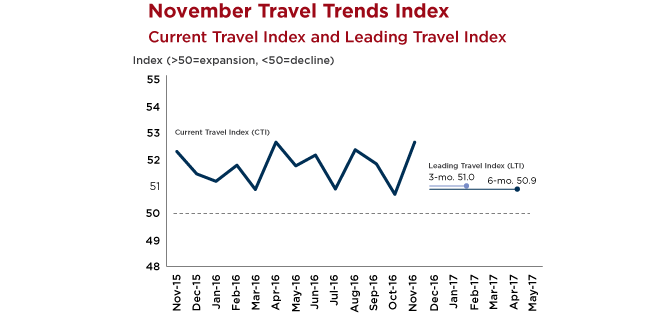Domestic business travel accelerates post-election, defying expectations; all sectors exceed six-month growth average
WASHINGTON (January 10, 2017)—The first monthly Travel Trends Index (TTI) to encompass post-election data signals a strong showing by the travel sector in the wake of Donald J. Trump's unexpected win last November.
All travel sectors grew at rates significantly above their six-month moving averages, according to the TTI—with notable, unanticipated growth in domestic business travel.
"Although we are optimistic about the prospects for travel under the new administration, frankly we were prepared to see a wary short-term reaction, particularly in demand for inbound international travel to the U.S.," said U.S. Travel Association President and CEO Roger Dow. "Not only has no downturn materialized, but we have seen surprising strengthening in some areas, particularly the long-foundering domestic business travel segment. It mirrors the strong upticks we have seen in the stock market and a number of other indicators.
"Political rifts aside, there's really no denying that the economic news has been pretty good since Election Night."
Even a relatively flat international travel segment should be seen as a victory, Dow said. The resilience of the inbound market has been remarkable in light of the many pressures it has encountered for months, including political and security disruptions abroad and, especially, the continued strong run of the U.S. dollar against other currencies.
The domestic business sector's growth outlook in the coming months, though still modest, reverses a losing streak during which it was the only TTI segment to spend most of 2016 in negative territory.
Despite domestic business travel's surprising reversal, domestic leisure travel will still remain the primary driver of U.S. travel growth into the beginning of 2017.
In the full TTI report, the 6-month predictive Leading Travel Index (LTI) reading of 50.9 indicates that total U.S. travel volume is expected to grow at a rate of around 1.8 percent through May 2017.
The TTI consists of the Current Travel Index (CTI), which measures the number of person-trips involving hotel stays and/or flights each month, and the Leading Travel Index (LTI), which measures the likely average pace and direction of business and leisure travel, both domestic and international inbound. It assigns a numeric score to every travel segment it examines—domestic and international, leisure and business—in current, 3-month and 6-month predictive indicators. As with many indices similarly measuring industry performance, a score above 50 indicates growth, and a score below 50 indicates contraction.
The U.S. Travel Association developed the TTI in partnership with Oxford Economics, and draws from multiple data sources to develop these monthly readings. In order to compile both the CTI and LTI readings, the organization's research team utilizes multiple unique non-personally identifiable data sets, including:
- Advance search and bookings data from ADARA and nSight;
- Passenger enplanement data from Airlines for America (A4A);
- Airline bookings data from the Airlines Reporting Corporation (ARC); and
- Hotel room demand data from STR.
Learn more about the Travel Trends Index.
Click here to read the full report.



